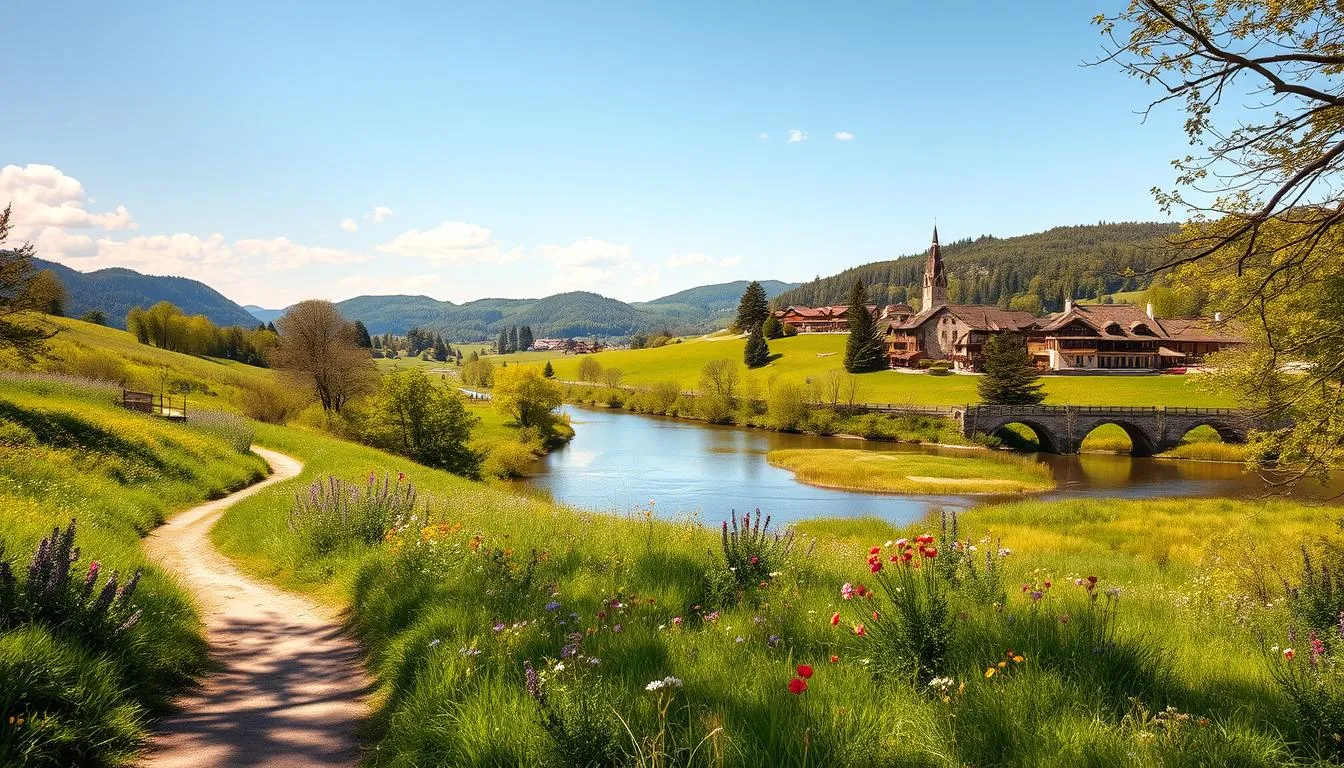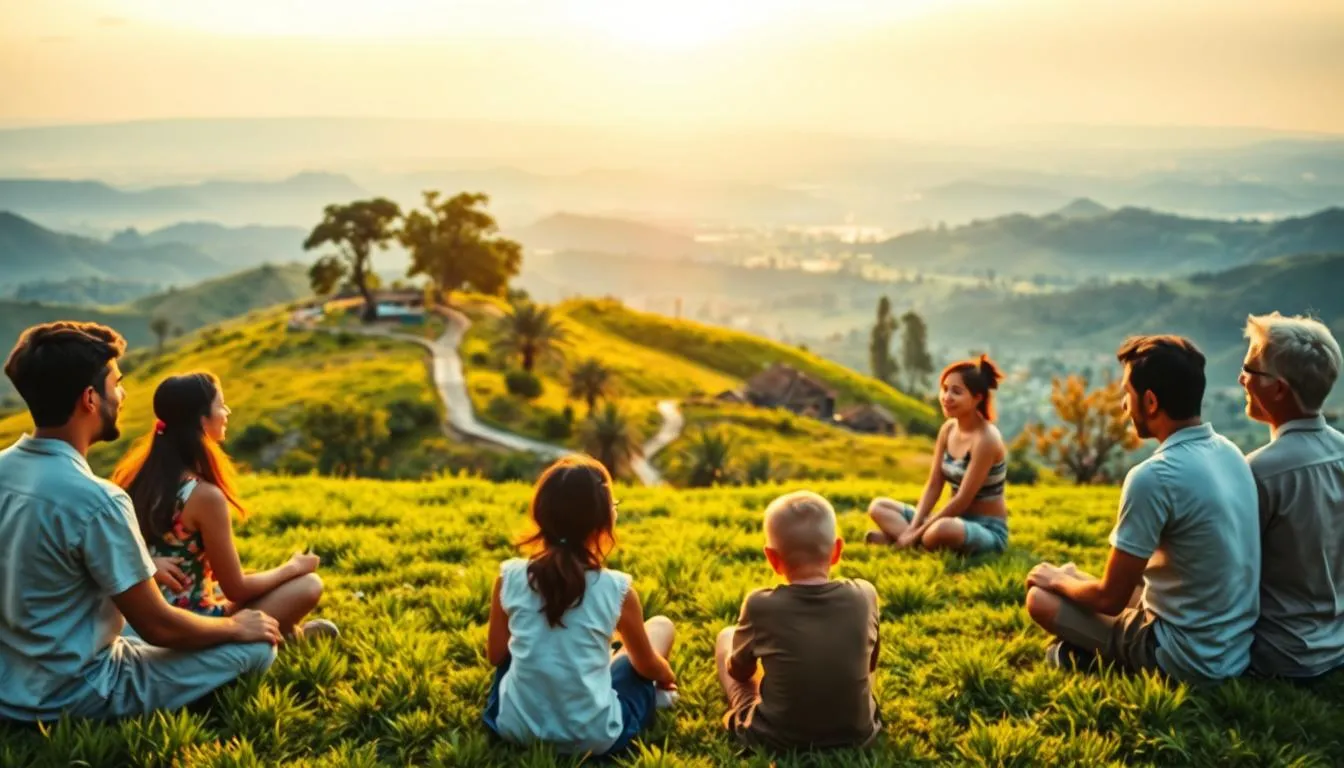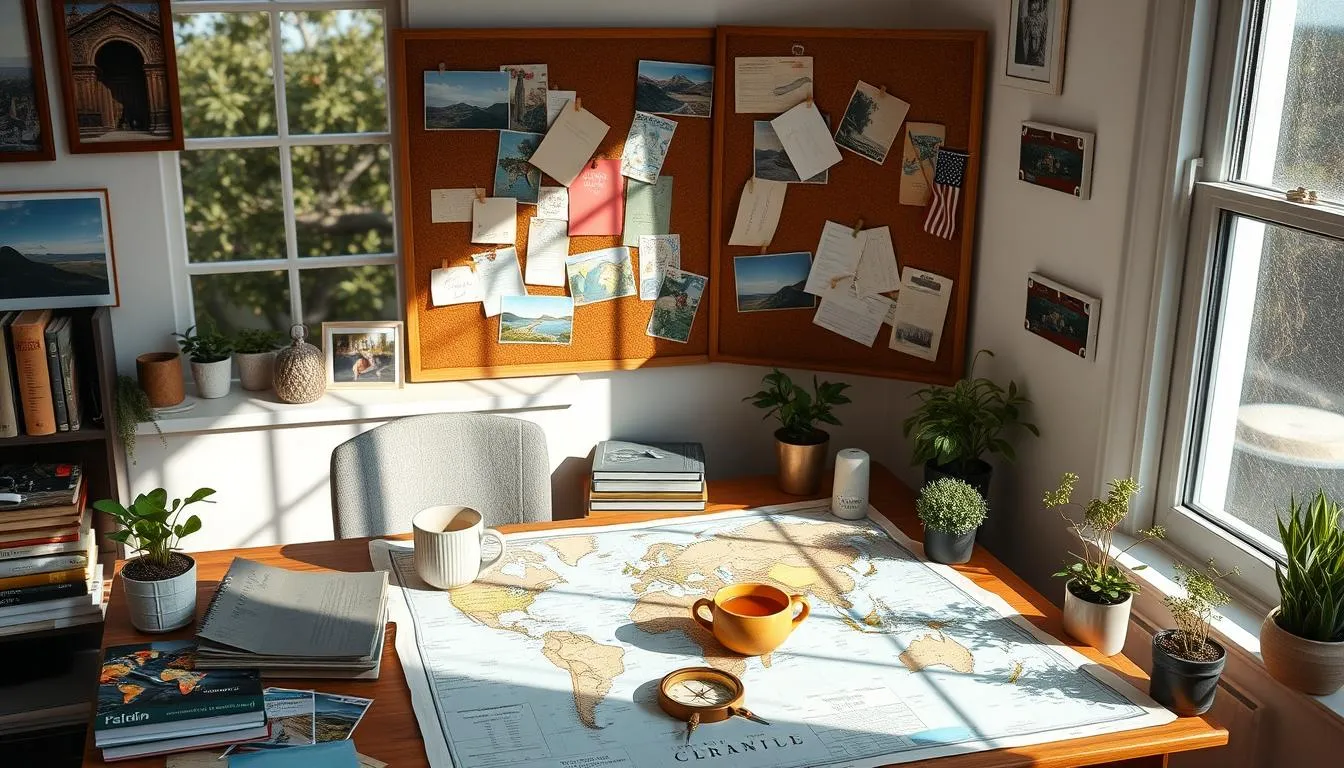Did you know a boutique culinary operator reported triple bookings in 2023 versus 2019, and 85% of Americans now want trips that let them truly experience local culture?
Slow travel reorients the way you plan a trip. It values the journey as much as the destination and asks you to linger, learn, and connect.
This approach helps you reclaim time on the road, reduce stress, and invite serendipity. It pairs longer stays with hands-on activities like cooking or language lessons for richer moments.
The core promise: with intention, you gain deeper meaning in fewer miles and create lasting stories. This guide will cover mindset shifts, planning pillars, immersive ideas, and sample U.S. routes.
Accessible to families, solo explorers, and anyone exploring nearby or across the country, this way of exploring supports local economies and fosters cultural respect without sacrificing adventure.
Key Takeaways
- Slow travel focuses on depth over speed for a richer travel experience.
- Lingering longer reduces stress and opens space for real connections.
- Immersive activities add meaning and help you learn local ways.
- Post‑pandemic demand shows more people want cultural, slower trips.
- This approach benefits local economies and respects communities.
What Is Slow Travel and Why It Matters Now
Slow travel grew from an idea first voiced at Italian tables in the late 1980s. The slow food movement urged people to savor meals and the company around them. That same spirit now asks travelers to savor places, not just move quickly between pins on a map.
From slow food to a wider philosophy
The lineage is simple: savoring a meal became savoring a place. In practice, this means choosing fewer destinations and giving each one time to reveal its rhythms.
Quality over quantity
Quality beats quantity. Instead of a bucket list checklist, this way of exploring values curiosity, conversation, and context. Moving less often helps a traveler spend more hours in markets, meet neighbors, and gain genuine understanding.
Why it matters now
After years of disruption, priorities shifted toward presence and well‑being. American Express found 85% of people want to truly experience local culture. Virtuoso noted many have left passport‑stamp collecting behind in favor of deeper stays.
“The value of a trip is no longer measured in miles but in moments.”

| Origin | Core idea | Modern benefit |
|---|---|---|
| Late‑1980s slow food | Savor meals, then places | Richer cultural experience |
| Fewer moves | Longer stays per destination | Lower cost, smaller footprint |
| Post‑pandemic shift | Depth over bucket list | Better well‑being and local ties |
Adopting a Mindful Travel Mindset and Pace
Choose to stay put for a few extra days and you’ll notice a place unfolding at its own pace. Planning longer stays in one place trades frantic checklists for slow mornings, neighborhood rituals, and richer experiences.
Resisting the rush: staying in one place longer
Instead of packing an entire country into a week, pick one or two towns and dig in. Book a language class, join a cooking lesson, or sit in cafés and talk to locals. These small choices create more meaningful interactions and deeper connections.
Being present: digital detox and intentional downtime
Set clear digital boundaries: airplane mode for morning hours, social posts only at night. Build slots of unplanned time into each day so you can wander, listen, and notice details like bakery aromas or street music.
- Choose one to three meaningful activities per day rather than cramming the schedule.
- Allow plans to change when a local tips you off to a hidden bakery, trail, or gallery.
- Make conversation a practice: ask open questions and listen to personal stories.
These shifts make every travel day calmer and more rewarding, and they shape a new way to enjoy your travel experience.
Learn more about mindful travel practices
Core Benefits: Deeper Connections, Culture, and Nature
Lingering in one neighborhood opens small daily rituals that turn strangers into friends.
 Meeting locals becomes natural when you return to the same café or market stall. Morning greetings, repeated chats, and shared laughter form deeper connections over time.
Meeting locals becomes natural when you return to the same café or market stall. Morning greetings, repeated chats, and shared laughter form deeper connections over time.
Meeting locals and building bonds
Staying longer invites recurring moments that grow into real relationships. People learn names, tell stories, and offer tips you won’t find on quick tours.
Immersive experiences through food, history, and everyday life
Take a cooking class, attend a language lesson, or join a community event. These activities make culture tangible and turn passive sightseeing into active learning.
Well‑being at a human pace: less stress, more meaning
Moving slowly eases fatigue and lowers stress. You leave restored, not depleted, with a richer understanding of place and people.
| Benefit | What it looks like | Why it matters |
|---|---|---|
| Deeper connections | Daily greetings, market chats | Builds trust and local insight |
| Immersive experience | Cooking or language lessons | Hands‑on learning and memories |
| Well‑being | Unhurried walks, park picnics | Less stress; more restoration |
Data point: 85% of people say they want to truly experience local culture, and guided stays often include classes that create meaningful interaction.
“Repeated contact with locals widens your understanding of traditions, history, and challenges.”
Slow travel Planning Pillars for an Unhurried Trip
Smart choices before you leave shape how fully you can soak up a place. Use a clear planning trip strategy to make space for real moments, not just checklists.

Choosing destinations that reward lingering
Prioritize secondary cities and small towns where authenticity shows in daily life. These travel destinations often welcome longer stays and meaningful contact with hosts.
Timing your journey
Plan for shoulder seasons to cut crowds and stress. National Parks and busy spots feel calmer then, giving you time to explore without rushing.
Crafting the itinerary
Design fewer moves and more days in each place. Fewer hotel changes reduce transit fatigue and increase unplanned discoveries.
Sustainable, local choices
Stay in B&Bs, cabins, or boutique inns to foster host tips. Build markets, family eateries, cooking or language lessons, and responsible tours into your days.
“A well‑paced plan trades hurry for real connection.”
Ways to Immerse Yourself in a Destination
Turn your itinerary into a loose map that rewards detours, conversations, and slow mornings. Let each day include room to wander so the journey becomes part of the joy.
Take scenic road trips and allow spontaneous detours
Design road trips that leave space for sunrise pull‑offs and roadside stands. Packing fewer miles into a day makes the road a feature, not a race.
Explore by train for landscape and leisurely stops
Choose train routes when you want wide views and hop‑on access to small towns. Trains give time to read, plan, or simply watch fields and coastlines roll past.
Walk, hike, or bike to connect with nature and neighborhoods
Walking tours and short hikes let you notice murals, gardens, and the small shops locals love. Biking opens quiet streets and parks at a human pace.
Plan around festivals, markets, and historic sites
Sync visits with a market or cultural festival to meet vendors and hear stories. Markets and sites are a great way to learn history through daily life.
Learn by doing: classes, tours, and longer journeys
Book a cooking class or a language lesson to turn food and history into immersive experiences. Longer journeys—like a pilgrimage or a multi‑week backpack—offer deep reflection and steady progress.
“Culinary exploration links you to a place’s past; one study found 81% of travelers seek indigenous cuisine.”
| Method | Best for | Why it matters |
|---|---|---|
| Road trips | Hidden spots, photo stops | Flexible pacing and local conversations |
| Train | Scenic views, station towns | Comfortable pace and hop‑off options |
| Walking/Bike | Neighborhood depth | Notice details and meet neighbors |
Transportation and Stays That Support the Experience
How you move between sights shapes the tone of every day on your trip. Choose options that match your goals: walking and biking help you meet people and notice small shops. Trains cut stress and carbon, while a car opens quiet road and trailhead access.
Practical lodging and movement choices
Many tour companies now design trips on bike or foot so guests get more local experiences and environmental contact. Stay in B&Bs, cabins, boutique inns, or home rentals where hosts share tips about food, markets, and neighborhood gems.
- Match transport to goals: walk or bike for connection; train for calm; car for remote spots.
- Set gentle start and end days so your pace feels natural and you can learn the rhythms of the place.
- Use a kitchen: shop markets, cook local food, and make meals part of the stay.
- Pick neighborhoods over highway hotels so each step outside feels like part of the destination.
“Choose comfort with character so where you sleep extends the story of the place.”
For a deeper primer on this way of exploring, see what is slow travel.
United States Slow Travel Ideas and Sample Routes
Plan a U.S. route that favors slow days and small discoveries rather than a packed must‑see sprint. Use longer stops to turn a trip into a real experience and let local rhythms lead the way.
Small towns and nature escapes
Visit National Parks in shoulder seasons—Acadia, Zion, and Glacier reveal their character with fewer people and softer light. Aim for weekday entries and sunrise or late‑afternoon hikes for quieter moments and better photos.
Coastal and countryside road trips
Choose coastal byways like Oregon’s Highway 101 or the Outer Banks where ferries, lighthouses, and boardwalks invite you to linger. Or map countryside loops through New England or Texas Hill Country with farm stands and wineries.
- Base in small towns near big parks so lodging feels calm while icons stay a scenic drive away.
- Plan food‑forward detours—clam shacks, taco trucks, and smokehouses—for a cultural taste that beats brochures.
- Allow slower segments each day: picnics, overlooks, and chats with locals make the journey part of the destination.
“Being part of a place matters more than covering distance.”
Keep routes flexible: add or subtract miles so your trip stays about curiosity, not a checklist. That way, the destinations become memorable for people, culture, and food as much as for views.
Conclusion
Turn fewer stops into deeper chapters so your next trip reads like a memory, not a checklist.
Prioritize meaning over mileage: pick one destination, add time, and choose a handful of experiences that reveal local culture and everyday life.
Simple moves—stay longer, eat local food, and talk with locals—transform a routine visit into a rich travel experience.
Bring a small habit home: journal one insight a day about the people and the place so culture stays with you after you return.
Whether a long vacation or a quick weekend, protect margins, plan fewer stops, and add a short tour or workshop to deepen context.
Book extra nights, leave room to wander, and let curiosity set the pace. For practical tips on adopting this approach, see what is slow travel.
FAQ
What is mindful exploration and how does it differ from a typical itinerary?
Mindful exploration focuses on spending more time in fewer places to notice everyday life, local food, and nature. Rather than a checklist of landmarks, it emphasizes slower pacing, deeper cultural encounters, and downtime that lets you absorb a place’s rhythm.
How long should I stay in one place to get meaningful experiences?
Aim for several days to a couple of weeks depending on the destination. Longer stays let you meet residents, discover neighborhood favorites, join markets or festivals, and move beyond tourist routines into authentic routines.
Which types of places work best for this approach?
Small towns, secondary cities, coastal villages, and national-park gateways shine because they reward lingering. These spots offer local eateries, nature trails, and community events that reveal culture and pace.
How can I plan an itinerary that supports unhurried days?
Build fewer moves into your plan: choose two or three bases, add flexible days for spontaneous detours, and schedule activities like cooking classes or walking tours that immerse you. Pick shoulder-season dates to avoid crowds and enjoy more time outdoors.
What transportation choices encourage a relaxed experience?
Trains, scenic drives, biking, and walking slow the journey and create chances to stop and explore. For longer stretches, choose daytime rail routes or coastal drives that let landscape be part of the trip.
How do I find authentic local experiences without a tour?
Visit markets, join community events, take a neighborhood walking tour, and ask shopkeepers or hosts for recommendations. Enroll in a cooking class or language lesson—hands-on activities connect you with residents and daily life.
Are there sustainable choices that fit an unhurried holiday?
Yes. Stay in B&Bs, boutique inns, or locally owned rentals; eat at markets and family-run restaurants; book small-group or community-based tours; and favor public transit or low-impact travel between nearby towns.
Can I practice this approach while on a road trip?
Absolutely. Plan shorter driving segments, build in scenic detours, and choose a few overnight stops rather than racing to a long checklist. This gives time for hikes, beaches, and local meals without fatigue.
How does this style affect my budget?
Spending more time in one place can reduce transport costs and let you find better-value local options. You might trade pricey hotspots for affordable neighborhood dining and markets, often stretching your funds while getting richer experiences.
What are good ways to stay present and avoid digital distractions?
Set specific offline windows, use your phone only for navigation or photos, and keep a travel journal. Turning off notifications and scheduling tech-free mornings helps you notice small moments and conversations.
How can I meet locals and build deeper connections respectfully?
Learn a few words of the local language, listen more than you talk, support family-owned businesses, and accept invitations to community events when appropriate. Be curious, patient, and open to slow conversations.
What if I only have a long weekend—can I still experience this way of exploring?
Yes. Choose one nearby town, limit your agenda, and focus on immersive activities like a market visit, a cooking class, or a long hike. Quality time in one place beats a frantic multi-stop trip.
Which U.S. regions are ideal for unhurried routes and nature escapes?
New England coastal towns, the mountain communities near Great Smoky Mountains, the lesser-known parks in the Intermountain West, and California’s smaller coastal towns offer slow-paced options with nature, food, and local culture to savor.
